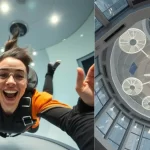Introduction
As the summer heat settles in, finding engaging activities to keep kids entertained can be a daunting task for parents. However, the Whitaker Center for Science and the Arts in Harrisburg, Pennsylvania, is here to save the day with a lineup of cool, hands-on science experiments that can be easily replicated at home.
Fizzy Fireworks: A Colorful Explosion of Science

One of the Whitaker Center’s most popular summer experiments is the “Fizzy Fireworks” activity, which allows kids to create their own miniature fireworks display right in their kitchen or living room. This simple yet captivating experiment not only sparks children’s interest in science but also taps into their natural curiosity and creativity.
Keeping kids engaged during the summer can be challenging, but incorporating fun and educational activities can make it easier. The Whitaker Center for Science and the Arts offers a variety of hands-on science experiments that are perfect for at-home learning. One standout activity is the “Fizzy Fireworks” experiment, which combines creativity and science for a spectacular display.
The “Fizzy Fireworks” experiment is a favorite among children and parents alike. It allows kids to create their own mini fireworks display using simple household items. This activity is not only visually stunning but also educational, teaching children about chemical reactions in a fun and engaging way.
Gather the Supplies
To get started with the “Fizzy Fireworks” experiment, you’ll need the following materials:
- Shallow dish or pan
- Glitter
- Food coloring
- Baking soda
- White vinegar
These items are commonly found in most kitchens, making this experiment accessible and budget-friendly.
Unleash the Creativity
Begin by inviting your child to design their own “fireworks” display using the glitter and food coloring. Encourage them to experiment with different colors and patterns. This step allows children to express their creativity and develop fine motor skills.
The Science Behind the Fizz
Once the colorful base is set, it’s time to add the science. Sprinkle baking soda evenly over the glitter and food coloring mixture. The real magic happens when you slowly pour white vinegar over the baking soda. The vinegar, an acid, reacts with the baking soda, a base, to produce carbon dioxide gas. This reaction causes the glitter and colored bubbles to rise and burst, creating a fireworks-like display.
The Wow Factor
As the vinegar is poured into the baking soda mixture, the chemical reaction unfolds, and the fireworks display begins. The kids will be mesmerized by the colorful bubbles and glitter erupting before their eyes, just like a real fireworks show. The excitement and wonder on their faces make this simple experiment truly unforgettable.
Extend the Learning
Once the fizzy fireworks have faded, engage your child in a discussion about the science behind the experiment. Explain the acid-base reaction, the production of carbon dioxide, and how the different components work together to create the colorful display. This reinforces learning and encourages critical thinking.
Keeping the Summer Brain Active
The Whitaker Center’s “Fizzy Fireworks” experiment is just one of many engaging, hands-on science activities available for families this summer. The center offers summer camps and online resources that provide numerous opportunities for kids to explore STEM (Science, Technology, Engineering, and Math) in fun and interactive ways.
Ignite the Spark of Curiosity
The “Fizzy Fireworks” experiment shows how simple, everyday items can be transformed into captivating science lessons. By tapping into children’s natural curiosity and love of hands-on learning, parents can foster a lifelong appreciation for science and inspire the next generation of innovators and problem-solvers.
More Experiments to Try
If your child enjoyed the “Fizzy Fireworks” experiment, the Whitaker Center has a variety of other experiments to try. Some include:
- Volcano Eruption: Using baking soda, vinegar, and a plastic bottle to simulate a volcanic eruption.
- Rainbow in a Jar: Creating a liquid rainbow using different densities of colored liquids.
- Oobleck: Mixing cornstarch and water to create a non-Newtonian fluid.
The Importance of STEM Education
STEM education is crucial for developing critical thinking and problem-solving skills in children. Engaging in hands-on science experiments helps children understand complex concepts and fosters a love for learning.
Creating a Science-Friendly Home Environment
Parents can encourage scientific exploration at home by creating a science-friendly environment. This includes:
- Providing a space for experiments
- Supplying basic science materials
- Encouraging curiosity and questioning
Safety First
While conducting science experiments at home, safety should always be a priority. Ensure that children are supervised, and that all materials are used safely. Discuss the importance of safety with your children before beginning any experiment.
Involving the Whole Family
Science experiments can be a fun family activity. Involving siblings and parents in the process not only makes it more enjoyable but also encourages family bonding and shared learning experiences.
Resources from the Whitaker Center
The Whitaker Center offers a wealth of resources for families interested in science education. From summer camps to online tutorials, there are plenty of opportunities to engage children in STEM learning.
Supporting Children’s Learning
Encouraging critical thinking and problem-solving skills is essential for children’s development. Science experiments provide a platform for children to ask questions, make observations, and learn through trial and error.
Fun with Everyday Items
Many science experiments can be conducted with everyday household items. This not only makes them accessible but also shows children that science is all around them. Examples include:
- Lava Lamp: Using oil, water, food coloring, and Alka-Seltzer tablets to create a homemade lava lamp.
- Invisible Ink: Writing secret messages with lemon juice that are revealed with heat.
Building a Science Kit
Creating a home science kit can make it easier to conduct experiments regularly. Essential items to include:
- Measuring spoons and cups
- Safety goggles
- Magnifying glass
- Basic chemicals (baking soda, vinegar, etc.)
- Craft supplies (glitter, food coloring, etc.)
Encouraging Curiosity
Nurturing a questioning mindset is key to fostering a love for science. Encourage your child to ask questions, explore their surroundings, and seek out answers through experimentation.
Conclusion
Engaging children in science experiments like “Fizzy Fireworks” is a great way to keep their brains active during the summer and foster a lifelong love of learning. By using simple household items, parents can create memorable experiences that ignite curiosity and inspire future scientists.
For a visual guide on how to conduct the “Fizzy Fireworks” experiment, check out this YouTube video tutorial.
FAQs
What is the “Fizzy Fireworks” experiment?
The “Fizzy Fireworks” experiment is a hands-on activity that involves creating a colorful display using baking soda, vinegar, glitter, and food coloring.
What materials do I need for the “Fizzy Fireworks” experiment?
You will need a shallow dish or pan, glitter, food coloring, baking soda, and white vinegar.
What is the science behind the “Fizzy Fireworks” experiment?
The experiment demonstrates an acid-base reaction between baking soda (a base) and vinegar (an acid), which produces carbon dioxide gas and creates a fizzy, bubbly reaction.
ow can I explain the experiment to my child?
Discuss the concepts of acids and bases, and explain how the reaction produces carbon dioxide gas, causing the bubbles to rise and burst.
Are there other similar experiments I can try at home?
Yes, other experiments include the “Volcano Eruption,” “Rainbow in a Jar,” and “Oobleck.”
Is it safe to conduct these experiments at home?
Yes, as long as safety precautions are taken and children are supervised. Ensure that all materials are used safely and discuss the importance of safety with your children.






